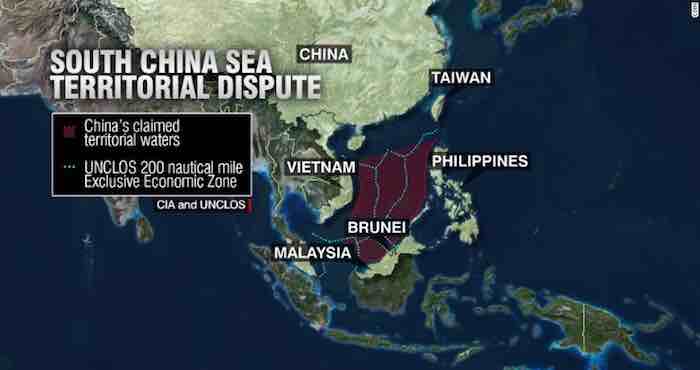The U.S. Navy’s “freedom of the seas” concept must prevail and be a key factor in maintaining Peace through Strength, and we must keep the South China open and free to all international commerce
Ensuring an Open South China Sea

On 20 April, 2018, Bill Gertz wrote an article about the written statement of the new Pacific command nominee, Admiral Philip Davidson, to the Senate Armed Services Committee. In his statement, Admiral Davidson conceded, in discussing the creation of China’s artificial islands and their militarization in the South China Sea, that they, in effect, have control over the entire area and “present a substantial challenge to U.S. military operations in the region.” Despite China’s President Xi Jinping’s statement on 25 September 2015 at the White House that he had no intention to militarize these islands, China has built four airfields on these islands, and has now installed not only air defense missile systems, but also anti-ship cruise missile systems. Nonetheless, these so-called “stationary island carriers” cannot move, and therefore are vulnerable.
The South China Sea is a key strategic international waterway and vital to our allies Japan, South Korea, Taiwan and the Philippines. Over $5 trillion dollars’ worth of commerce transit the South China Sea on an annual basis. This critical flow of commerce must not be subjected to the whims of an aggressive China.
It should be remembered that this is not the first time the U.S. Navy has been challenged in implementing its “freedom of the seas” concept. When I took command of the U.S. Second Fleet and the NATO Striking Fleet in July, 1981, the conventional wisdom then was that we could not operate north of the Greenland-Iceland-United Kingdom (G-I-UK) gap. It was the so-called maritime “Maginot” line. We had ceded the Norwegian Sea, that is, everything north of the G-I-UK gap including our allies Norway, Iceland and Greenland, to the Soviet Union. Clearly, there was a defeatist mentality that existed then as it does somewhat now.
I knew we had to fundamentally change the way we were operating in the North Atlantic and the Norwegian Sea. The fleets were still operating basically using World War II circular (Form40) carrier battle group formations which could be easily tracked by Soviet satellites. With the devastating reduction in force levels and readiness that were imposed by the Carter Administration, we had to develop innovative ways to operate. At that time, it should be recalled that President Reagan declared his “Peace through Strength” concept. The centerpiece of that concept was his commitment to build a “600-ship” Navy. Secretary of the Navy John Lehman was given the mantle to implement that very ambitious but critical program. Of course in July 1981, all of those new ships, submarines and aircraft were only on the drawing board. We had to implement our “Maritime Strategy” with the forces and equipment we had in hand.
To confuse Soviet satellites, we went to innovative dispersed dispositions with our Carrier Battle Groups along with the naval assets from our allies. We also integrated U.S. Air Force assets into our operation. Further, we introduced a number of novel cover and deception techniques, which are still applicable today. In our first major NATO fleet exercise in August and September 1981, Ocean Venture, we were able to operate for over four days in the North Atlantic undetected by Soviet forces. We were actually implementing the Navy’s Maritime Strategy, which was designed to be offensive, by developing the capability to attack the Soviet Union and their forces in their own area. For all practical purposes, the G-I-UK gap Maginot line did not exist. One of my greatest challenges was to convince our allies that we could prevail and win. For more details see John Lehman’s new book, “Ocean Venture,” coming out next month.
What Admiral Davidson will be facing in the South China Sea will not be all that different from when we faced off with the Soviet Union in the Norwegian Sea, which was much closer to our homeland. I agree with Admiral Davidson’s remarks on the need for new hypersonic ballistic and cruise missiles to counter China’s aggressive moves in the South China Sea and elsewhere. In that sense, I fully support our withdrawal from the U.S.-Russia Intermediate-range Nuclear Force Treaty (INF).
Fortunately, President Trump like President Reagan subscribes to the “Peace through Strength” concept. Also like President Reagan, he has embarked on a rapid build-up of our naval and other military forces after the disaster created by former President Barack Obama and his “sequestration” policy. As a result of that policy, we have the smallest army since WWII; the smallest Navy since WWI; the smallest Air Force in its history, with the U.S. Marine Corps suffering similar negative impacts.
Clearly, China’s rapid build-up of its military forces and the deployment of sophisticated new anti-ship ballistic and inter-continental missiles pose a serious challenge. However, there is a software that has been tested repeatedly and proven to be over 95 percent effective in killing hypersonic maneuvering warheads. It is called Hypersonic Intercept Technology (HIT), which can be incorporated in all of our anti-ballistic missile systems and would “checkmate” not only Chinese, but Russian missiles as well. Such a defensive capability would dramatically change the strategic equation. With such a capability combined with our current forces and those of our allies, China’s “stationary island carriers” can be totally neutralized. However, we must be innovative in the way we operate in contested areas. The U.S. Navy’s “freedom of the seas” concept must prevail and be a key factor in maintaining Peace through Strength, and we must keep the South China open and free to all international commerce.
James A. Lyons, Jr. Admiral, USN (ret) -- Bio and
Archives |
Comments
James A. Lyons, a retired U.S. Navy admiral, was commander in chief of the U.S. Pacific Fleet and senior U.S. military representative to the United Nations.

 On 20 April, 2018, Bill Gertz wrote an article about the written statement of the new Pacific command nominee, Admiral Philip Davidson, to the Senate Armed Services Committee. In his statement, Admiral Davidson conceded, in discussing the creation of China’s artificial islands and their militarization in the South China Sea, that they, in effect, have control over the entire area and “present a substantial challenge to U.S. military operations in the region.” Despite China’s President Xi Jinping’s statement on 25 September 2015 at the White House that he had no intention to militarize these islands, China has built four airfields on these islands, and has now installed not only air defense missile systems, but also anti-ship cruise missile systems. Nonetheless, these so-called “stationary island carriers” cannot move, and therefore are vulnerable.
On 20 April, 2018, Bill Gertz wrote an article about the written statement of the new Pacific command nominee, Admiral Philip Davidson, to the Senate Armed Services Committee. In his statement, Admiral Davidson conceded, in discussing the creation of China’s artificial islands and their militarization in the South China Sea, that they, in effect, have control over the entire area and “present a substantial challenge to U.S. military operations in the region.” Despite China’s President Xi Jinping’s statement on 25 September 2015 at the White House that he had no intention to militarize these islands, China has built four airfields on these islands, and has now installed not only air defense missile systems, but also anti-ship cruise missile systems. Nonetheless, these so-called “stationary island carriers” cannot move, and therefore are vulnerable.